Shortly before his death, my father, Mr Len Pack (born 12.6.1907 - died 5.3.1976), started to write his memoirs of a life spent in Higham Ferrers. Unfortunately, he only completed five pages, covering his early childhood.
He was born on the 12th June 1907 at No 1 Wood Street, the youngest of eight, having four brothers and three sisters. My Father describes his bedroom there as having a most unusual ceiling. It had the appearance of an upturned wooden boat, with the main beams continuing right down to the floor. Ugly gargoyles were carved at about bedstead level. On waking in the morning he would see these faces looking at him. He remembers the house was a very spooky place and his sisters were always afraid to open the cellar door. Surveys in recent years have discovered that No 1 and No 3 Wood Street are the remains of a 15th Century Mediaeval 'Open Hall Building'.
The living room was originally open to the roof and heated by a central open fire. Inspection of the roof space, with its smoke blackened rafters, confirms this theory. The strange ceiling my father slept under for the first eight years of his life, still retains its 15th Century arched braced trusses and wind braces. The building, remodelled in the 18th Century, is now Grade II listed.
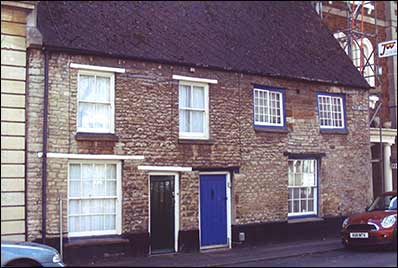 |
|
1-3 Wood Street, Higham Ferrers in 2010
|
Father writes, they were a very poor family, but my grandfather, Arthur Pack (born 29.8.1864 - died 3.10.1915), had an ideal and that was to co-operate with his fellow workmates. From this the 'Higham Ferrers Co-operative Boot and Shoe Productive Society Limited' was born.
This came about by great sacrifice by my grandmother, Ellen Pack (nee Coles 1863 - 1931), who did 'stabbing' to feed and clothe the family. Stabbing is sewing the leather upper of boots and shoes together by hand, with hemp thread. This has to be waxed by hand, a bristle is fixed to the end and the pieces of leather, to be sewn together, are placed in a wooden clamp, which is held between the knees. A hole is then stabbed in the leather, using an awl, into which the bristle is pushed. One must remember there were no sewing machines to do this work and it had to be done by hand. A journey to Raunds, pushing a hand cart, was made twice a week, to fetch and take back the completed work, so this meant a walk of approximately 20 miles a week, to keep the household going. My grandmother was a Raunds lady, the oldest of thirteen.
I was aware Grandfather had been a Borough Councillor and had played his part in founding the Higham Ferrers and Rushden Water Board. In fact, he was so enthusiastic for the proposal to build a reservoir at Sywell that objectors called it 'Pack's Folly'. It proved to be a great success and, although no longer used as a reservoir, it still serves the community as a very popular country park, to this day.
Having no knowledge of Grandfather's involvement in the Co-operative movement, or the founding of the Higham Ferrers Boot and Shoe factory, I decided to research the history of the enterprise.
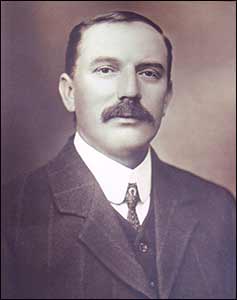 |
|
Mr Arthur Pack, 1908
|
The boot trade in the 1890s was rapidly changing and adopting the factory system, with its introduction of machinery. The old way of working at home was drawing to a close. In 1891 Grandfather and his friend, Mr Solomon Upton decided to try and form a co-operative to produce boots and shoes in Higham. With this in mind Mr Upton visited his native town of Banbury. There, he was shown round the flour mill and other co-operative establishments. This gave the inspiration for the application of the same principle to the boot and shoe industry in Higham.
On December 2nd 1891, Arthur Pack, Harry Burgess, John Webb, Tom Kent and George Kent met at the home of Solomon Upton to consider if it would be advisable to start manufacturing, so that they could reap the benefit of their own labour. The six pioneers were very cautious not to let their employers know they were contemplating the establishment of a factory likely to compete with those of the commercial order. Secrecy was paramount.
On January 26th 1892, they met again in company with friends: J W Draper, G Pashler, W Litchfield, J Horsefield, C Litchfield, F Clark and S Stanley. They resolved themselves into the provisional committee of the new society and elected S Upton president; W Litchfield secretary; and G Kent treasurer. Then they got down to business details and decided to convene a public meeting at the trade union headquarters on the 29th, engaging the Town Crier to go through the town the day before, announcing the event.
On January 29th 1892, the 'Higham Ferrers Co-operative Boot and Shoe Productive Society Ltd' was launched, with members subscribing a shilling a week to invest in the project. Grandfather's income at this time was 5/6 a week and he was paying 2 shillings of this to the fund, so I can understand why my grandmother had to work so hard.
The society commenced production in 1894 with a capital of £300, in a little workshop in Wood Street, using the 'Ivy Brand' trade name.
By 1902 the share capital was well over £1000 and business was advancing beyond the capacity of the works. In 1904, to hasten progress, they bought land in Kimbolton Road and erected a large factory, equipping it with the most modern machinery.
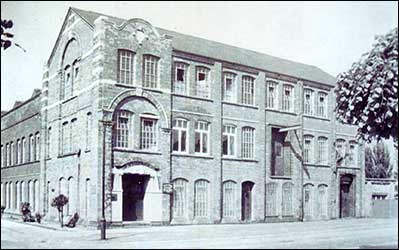 |
|
Higham Ferrers Co-operative Boot and Shoe Productive Society Ltd factory in Kimbolton Road
|
The society also presented the Borough Council with an avenue of lime trees along the highway, to give a naturally fine approach to the town.
In 1908 the Society presented Grandfather with a large oak framed photograph. The citation reads: - 'Presented by the Higham Ferrers Co-operative Boot Society to Mr Arthur Pack as a recognition of his valuable services as president for the past nine years. July 1908'.
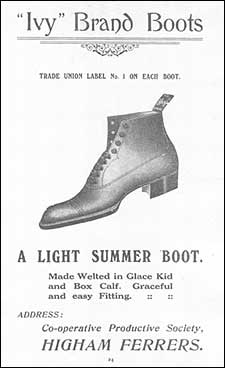 |
|
Ivy Brand
|
|
In an interview published in the Rushden Echo, Grandfather refers to the first time he swaggered home with nine shillings for a week's work. His favourite quotation was, 'The wealth of a nation first, and its peace and wellbeing besides, depend on the number of persons it can employ in making good and useful things'. I think this quote really sums up the man he was.
The following amusing article was published in a national magazine in 1909:- 'Those who delight in the prosperity of the small communities of the countryside can give a practical side to their faith by wearing the 'Ivy' boots which come from Higham Ferrers. The manufacture of footwear is the chief industry of the district, although agriculture has a place and the whole town is surrounded by farming land. At the top of the trade is the Co-operative Factory which has helped to raise the conditions of labour and increase the wages paid all round. It stands in the highest part of the town and is surrounded by green fields, the approach being between an avenue of lime trees. There, three storeys, erect to all the wind that blows, stands the splendid home of a capital society'.
Between 1904 and 1913 the annual sales doubled to well over £21,000. In 1913, 800 square yards of land facing Chichele Street, behind the factory, were acquired to extend the building. In the autumn of 1914 the society received a contract for the supply of boots to the British Army and tendered successfully to make boots for the Italian Army. Under a 'Defence of the Realm' Order of 1916, the War Office commanded the society to devote the greater part of its output to the production of boots for the British, Italian and Russian armies: long boots for the Cossacks; trench boots for the British troops.
|
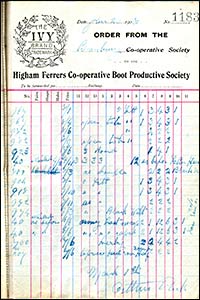 |
| On January 20th 1908 Arthur Pack visited Banbury Co-op and they wanted the order on March 1st. The next day he went to Chipping Weston Co-op, who wanted the order by March 11th, and to Gloucester who asked for delivery 'as soon as ready'.
On the 22nd Stroud Co-op asked for their delivery to be on 1st May and for "White bottoms to all numbers, Studs in all best work." Before the end of January he had also been to Barrow.
The following ticket is dated May 6th, and he was at Brierfield Co-op who requested a June 2nd delivery, and the next day he was at Congelton Co-op and they chose a June 10th delivery.
[end of book - earlier it was used by a colleaque]
|
|
|
A page from an order book used by Arthur Pack when he was a traveller for the company.
|
|
Output of the society halved in the economic depression of the 1920s. In the crisis during the 1930s, members were on short time, working a three days on and three days off system. By 1935 trade was reviving and in 1937 the year's turnover had doubled that of 1934.
1939-45 were anxious years of great endeavour. In 1940 the installation of electrical equipment throughout the works, and new machinery in many sections, quickened output and a trading record of £80,000 was made in 1942. But supplies to distributive societies had to be conditioned to national needs and much of that year's production was for Government contracts and the urgent demands of H M Forces.
When peace dawned in 1946 and army orders relaxed, the production of the highest grade of men's and youth's shoes and a variety of fashionable footwear for ladies went forward. Special displays in 1947 of the 'Ivy Brand' shoes for women, as well as those for men, at the International Exhibitions held in Chicago and Copenhagen gave co-operative production a fitting place in the markets of the world and sales of over £100,000 for the year was another record.
With business prospering a spacious canteen was erected on land adjoining the factory in Chichele Street. Sadly this was not to last. By the 1950s the boot and shoe industry was in decline, mainly caused by cheap imports. By the end of the decade the co-operative had ceased production.
The society, in many cases, had been a family affair as the years progressed, although my father did not work then, with descendants of the founding fathers, sons, grandsons and other family members had followed in their footsteps. In my family alone at least eight uncles, aunts and cousins had worked there, producing the 'Ivy Brand' footwear.
From 1960 onwards the factory buildings were occupied by various electrical companies: Oberman’s, Harvey Hubble and Watford Electricals. In the late 70s (or early 80s), the factory was sold to Colin Cross leather factors.
The buildings were finally demolished in 2008 to make way for a proposed housing development.
Graham Pack
|
Rushden Echo, 13th July 1928, transcribed by Kay Collins
Outing
Forty-six members of the Higham Ferrers Co-operative Boot and Shoe Productive Society held their annual outing on Saturday. They left Higham by charabanc at 8a.m. and went to Coventry, Warwick, and Kenilworth, short stays being made at each place. At Leamington, the next place to be visited, a good time was spent. Tea was served by the Co-operative Society and at the tables complimentary speeches were made by Messrs W Smith (secretary of the society), H Wooding, E Tearle, and A Chaplin. On the way home halts were made at Daventry and Northampton. Mr Smith and a committee of the factory made the arrangements.
|
|